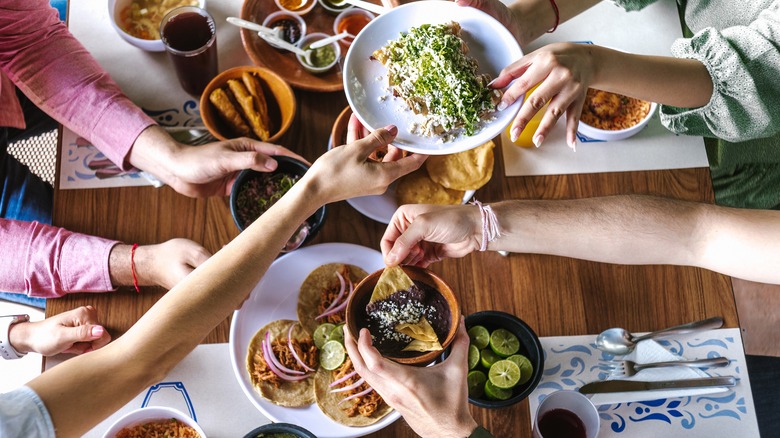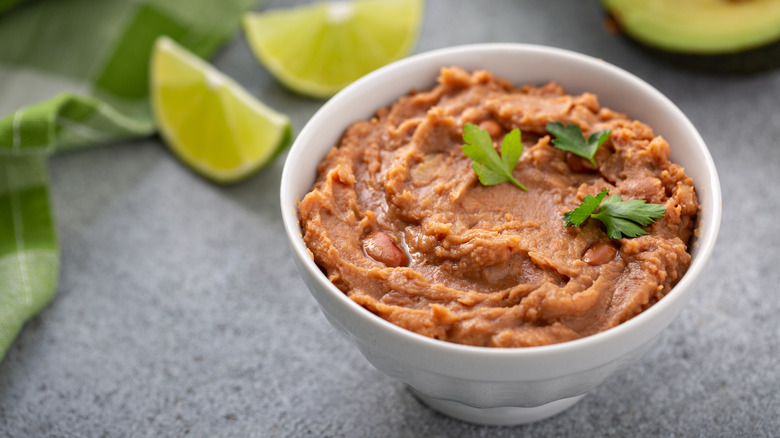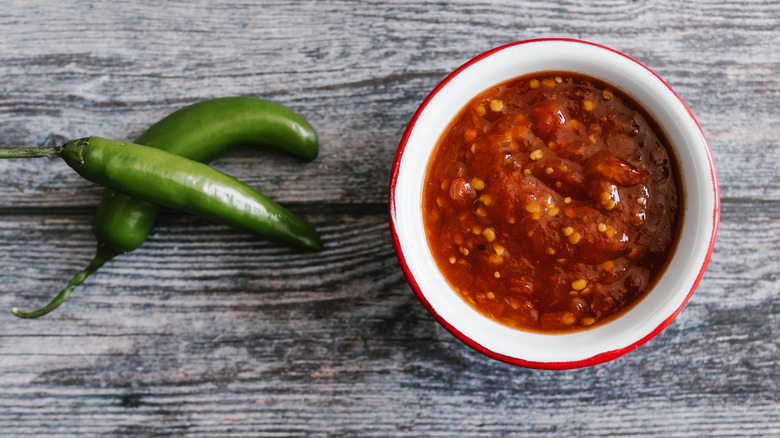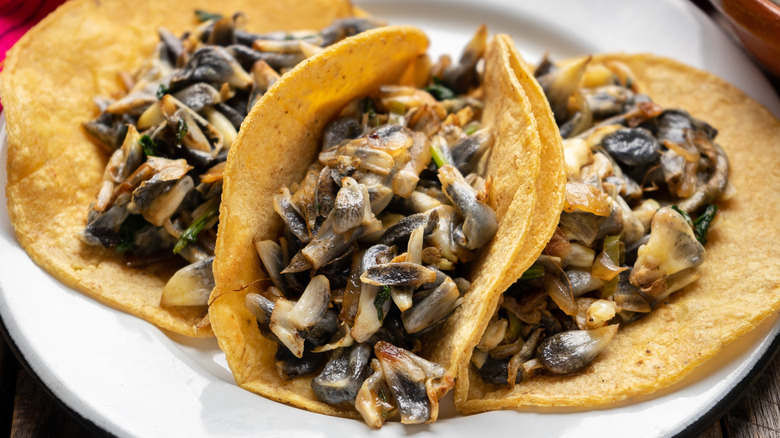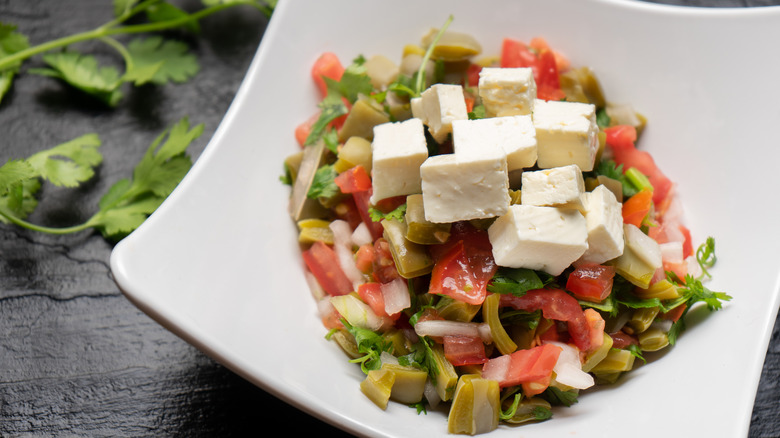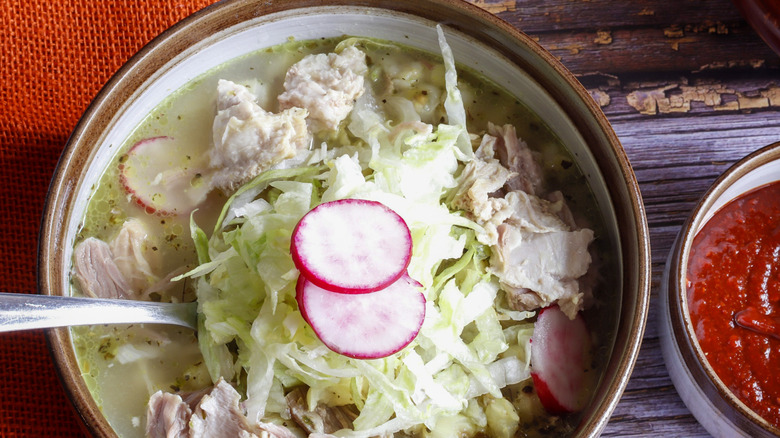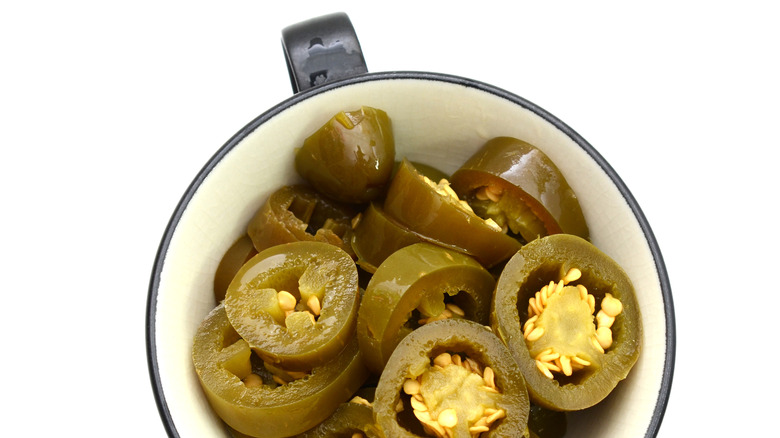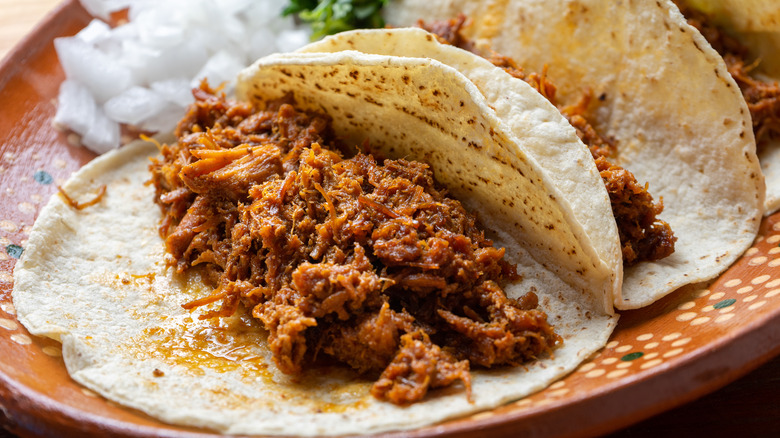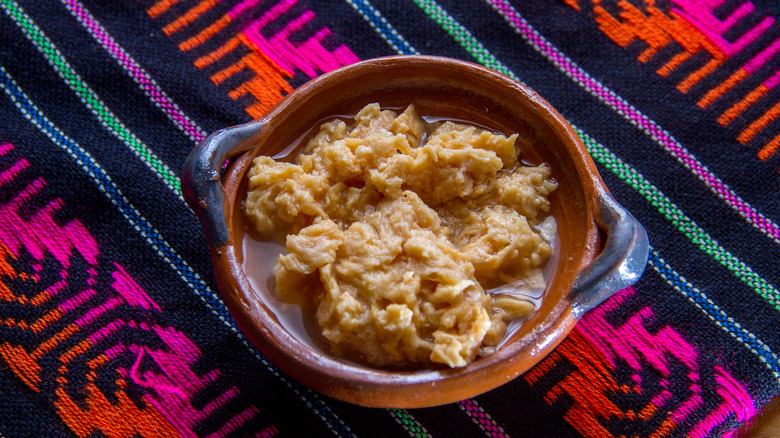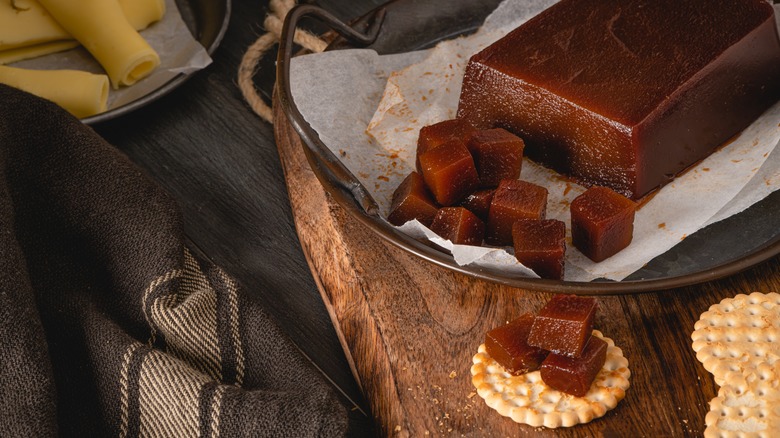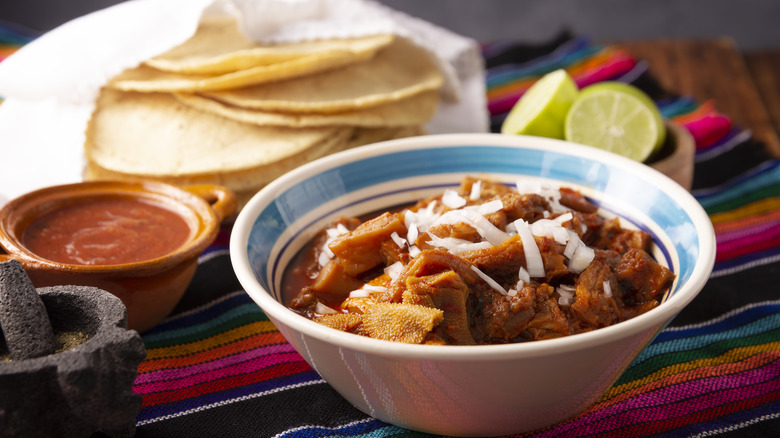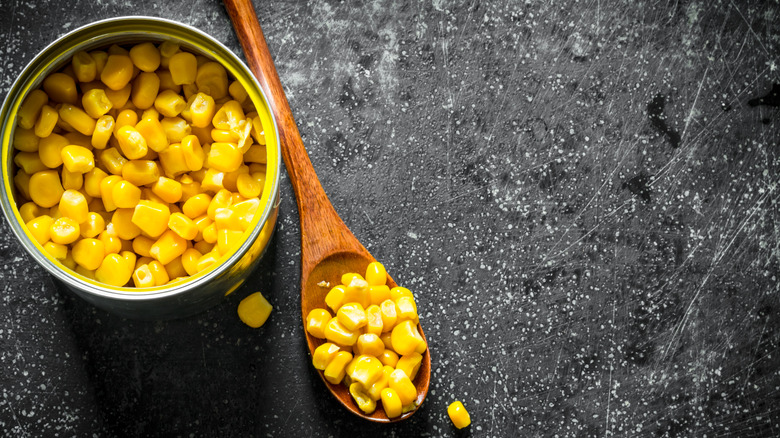12 Canned Mexican Foods You Should Know About
Endlessly rich and complex, Mexican cuisine is the product of centuries of traditional farming practices, culinary techniques, and rituals, which earned it the title of Intangible Cultural Heritage of Humanity from UNESCO in 2010. It encompasses a wide variety of ingredients, such as corn, beans, cocoa, and vegetables, which are used in fascinating recipes with regional variations, like mole and cochinita pibil. This cuisine is not only incredibly delicious but also beloved by Mexican nationals and foreigners alike.
While much of its value lies in these centuries-old recipes and traditions, as well as in its wonderful ingredients, the truth is that we don't always have the time to prepare the dishes we'd like to make from scratch or don't have access to fresh ingredients. Luckily, there are plenty of canned goods we can stock up on to make those dishes that remind us of home — or of that lovely trip to Mexico. These are some of the best canned Mexican foods you can have in your pantry.
Beans
A staple of Mexican cuisine since pre-Hispanic times, beans are a basic in any pantry in the country. Some of the most popular varieties are black, pinto, and kidney beans, and they can be the main stars in a dish, such as sopa de frijol negro (black bean soup), or serve as a foolproof side in countless dishes, from stews to grilled meats to enchiladas.
Beans are, as you may have guessed, one of the most popular items you'll find in a can. Black and pinto beans can be used as ingredients when preparing soups, sauces, or stews, and can also be heated up and served whole. When it comes to sides, you can't go wrong with refried beans, which are pinto beans that are cooked with salt and seasonings, then mashed and fried. Brands like Rosarita and Old El Paso carry several versions of refried beans, including jalapeño-seasoned and fat-free.
Salsa
Salsa is the centerpiece on every Mexican table, capable of livening up pretty much any dish, from a simple quesadilla to a fried egg or grilled chicken breast. There are countless recipes, styles, and heat levels when it comes to salsas, and while tradition calls for making it in a stone molcajete (or a blender), there are plenty of canned options that can bring the heat when time is of the essence.
Salsa roja (traditionally made with red tomato, onion, garlic, and serrano or jalapeño peppers) and salsa verde (with tomatillos, onion, jalapeño pepper, lime, and cilantro) are absolute basics. You can also find canned versions of salsa ranchera (usually made with roasted tomatoes, onions, serrano peppers, and garlic) and chipotle salsa, all of which can be served straight from the can. You can also find salsas for cooking, like enchilada sauce, from brands like Rosarita and Las Palmas.
Huitlacoche
Beloved by many and misunderstood by others, huitlacoche is one of the most fascinating ingredients in Mexican cuisine. Huitlacoche is a fungus known as smut that grows on corn, and while the word fungus might not sound very appetizing to some people, it is actually a delicacy, with a deep, smokey flavor, and has been part of the country's culinary culture for centuries, per Food Republic. In fact, its name comes from the Nahuatl language spoken by the Aztec and Toltec civilizations.
Rainy months are best for finding fresh huitlacoche at the market, but its canned counterpart is, of course, available year-round. You can use this ingredient as you would use any mushroom, adding it to sauces or stews, or sautéing it and serving it as a side dish. It is also an excellent way to elevate simple scrambled eggs or a quesadilla, as its rich flavor pairs very well with cheese.
Nopales
In the science world, the prickly pear cactus is known as opuntia, while in Mexico it is called a nopal. Its paddles are edible and considered a vegetable — and a pretty nutritious one, at that. According to Healthline, nopales are high in antioxidants, have antiviral and neuroprotective properties, and can even help regulate blood sugar levels.
Aside from their nutritional value, nopales are deliciously versatile, as they are equally great in soups, stews, tacos, or a fresh nopal salad made with tomatoes, cilantro, and shredded cheese. They are also a perfect addition to scrambled eggs, adding both freshness and a nice crunch.
Canned nopales are extremely practical, saving you the time it takes to wash and slice them, and sometimes watch for a couple of leftover thorns. Brands like La Preferida and San Marcos carry canned nopalitos in light brine, so all you need to do is drain them and add them to whatever you're preparing.
Pozole
Hot, hearty, and comforting, pozole is a popular dish across Mexico, as delicious during a family celebration as it is effective during a particularly rough hangover. There are various versions of pozole, but most of them are made with hominy (cacahuazintle corn), pork meat, and garlic, then topped with shredded lettuce, onions, radishes, lime, and avocado, and served with tostadas and cream on the side.
The most popular kinds of pozole are verde (green), made with tomatillos, cilantro, and serrano or jalapeño peppers; rojo (red), with red chili peppers such as guajillo or ancho; and blanco (white), which does not include any chilis in the broth but can be served with salsa on the side. Pork meat can be swapped for chicken in many versions, too.
Preparing pozole takes some considerable time and effort, but fortunately, there are some solid canned versions to satisfy your cravings if you are time-deprived. You can find green and red pozole, both with chicken or pork meat, that require nothing but a trip to the store and the toppings of your choice before being served.
Peppers
Chili peppers appear in hundreds of Mexican recipes and are used as a common condiment. There are more than 60 types of chili peppers produced in Mexico, per MasterClass, and their wide variety of shapes, colors, textures, and heat level means they can be used in countless ways.
Some chili peppers are eaten fresh, like serranos. You can slice up these bright, green fellows and mix them into guacamole or pico de gallo salsa. Others are aged, dried, and smoked, which leaves them ready to become an integral part of stews, salsas, adobos, and moles. Chile pasilla, for example, is a chilaca pepper that has dried and become dark and wrinkly, like a raisin (hence the "pasilla" name). Pasilla peppers are used in complex sauces, like Oaxacan moles.
When it comes to canned chili peppers, you'll find a wide assortment: from tender peppers canned in brine, perfect for adding to guacamole, a tuna salad, or a ceviche; to pickled jalapeños that can bring the heat to any torta or sandwich; to smoked chipotles in adobo sauce, ideal for a homemade stew.
Condensed milk
Condensed milk may be a pretty universal ingredient: it's made with cow's milk that has been concentrated and sweetened with sugar. For many of us who grew up in Mexico, there is one brand that is superior to them all: La Lechera, whose condensed milk has no equal. The brand has been around since 1936, becoming a mainstay in millions of Mexican kitchens. La Lechera is pure thick, sweet goodness, present in countless classic desserts such as flan and tres leches cake, and as a topping in pancakes, or bowls of fruit, like strawberries and bananas. Some of us may have taken a couple of spoonfuls out of the can every once in a while.
These days, there are lactose-free and low-fat versions of this beloved sweet ingredient, as well as canned dulce de leche that you can incorporate in recipes or simply spread on cookies for a good old-fashioned treat.
Chilorio
Hailing from the northern state of Sinaloa, chilorio is a tasty stew made with pork meat cooked in a sauce made with pasilla or colorado chili peppers, garlic, vinegar, and spices like cumin, oregano, and pepper. The resulting meat is soft enough to be shredded and is usually served in tacos — either with corn or flour tortillas — that can be topped with pickled onions and beans. This rich, flavorful stew is also used as a topping for tostadas, a filling for chimichangas and burritos, and tastes great when scrambled with eggs in the morning. Chilorio can also be prepared with beef or chicken, or even fish like tuna.
When you're working with canned chilorio, preparation is quite simple. All you need to do is heat it in a pan with the seasonings or toppings of your choice (some chopped onions or parsley are always a nice addition), and then wrap it up in warm tortillas.
Chongos zamoranos
This old-school Mexican dessert may have a slightly confusing look, not to mention a funny name: the word "chongo" is Spanish for "bun," as in the one you wear in your hair, while zamorano refers to the city of Zamora, Michoacán, where the recipe originated. However, all confusion disappears when you take a first bite of this sweet treat, made with curdled milk, cinnamon, and sugar. To prepare classic chongos, the curdled milk is cut into chunks that are cooked on a low flame and then cooled and sweetened with sugar, water, and cinnamon. Chongos can be stored in this syrup for a long time, making them perfect for canning.
You can find canned chongos zamoranos from brands like Tres Reyes, Coro, and La Herradura. For a practical dessert, you can serve them straight out of the can, and add a cinnamon stick as a cute garnish.
Quince and guava paste
Fruit paste is a very traditional sweet in Mexico and one of the many treats we inherited from the Spanish. Fruit paste can be made with several fruits, such as guava, pear, apple, and quince, and is available in candy shops and grocery stores across the country.
Quince paste in particular can be traced back to Southern Europe, as this fruit has been cultivated in the region for centuries, explains Delighted Cooking. Though it is quite bitter in its raw form, once it has been chopped, boiled, and mixed with sugar and lemon juice, it becomes a sweet jam or a thick paste. If properly stored, the paste can last several months, which makes it a very convenient dessert to enjoy in its canned version.
Fruit paste is a particularly popular sweet around the holidays, and is usually served with a slice of manchego cheese or Graham crackers. Canned fruit paste is available from brands like Goya and La Costeña, and can be enjoyed immediately after unpacking.
Menudo
Menudo, known as "pancita" in some regions, is a stew made with beef tripe (or "panza de res"), spices, and corn. Some people are not fans of this dish, as they find it too heavy or don't particularly enjoy the flavor and texture of tripe. However, menudo does have legions of fans, who love its hearty, comforting flavor and rich texture.
According to Larousse Cocina, menudo recipes vary from region to region. In the state of Chihuahua, for example, it is made with beef tripe, garlic, and onion, and the broth is thickened with beef legs and colorado chili pepper. The dish is served piping hot, topped with chopped onions, oregano, and a squeeze of lime juice. If you're in the State of Mexico, you'll find a slightly different version: while the broth is made with chilaca and pasilla chili peppers, garlic, and epazote leaf, the toppings are the same.
When it comes to canned menudo, you can also find various versions, such as corn-free, or with a spicier sauce. All you need to do is heat it up, add your preferred toppings, and serve with a few warm tortillas on the side.
Corn
The most sacred of Mexican ingredients, corn is a native crop to the country, and it was first domesticated in Mesoamerica around 8,500 years ago, according to WBCSD. There are more than 60 varieties of corn in Mexico, according to Food and Power, and two-thirds of farmers in the country plant their own native strains. Corn is so deeply linked to Mexican cuisine and culture that some Mexican people call themselves "the people of corn." It is used in countless dishes, from tortillas to tlayudas, huaraches, sopes, or pozole.
While you can't use canned corn to make tortillas, you can use golden corn to make a simple version of esquites, one of the tastiest street snacks in Mexico, with mayo, lime juice, powdered chili, and fresh Cotija cheese. You can also use golden corn in salads or as a side dish. Hominy corn is also available in a can, and you can use it to prepare stews like pozole or menudo.
